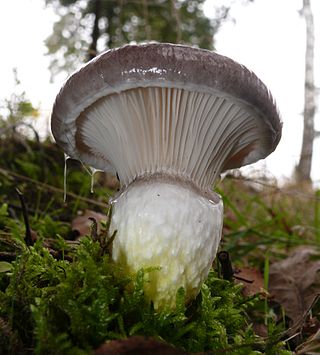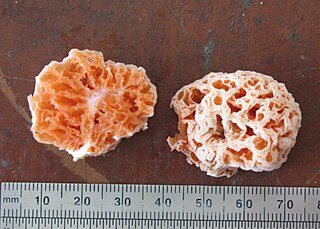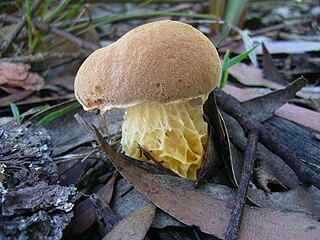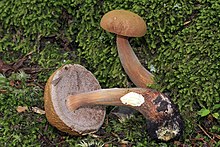
Tylopilus is a genus of over 100 species of mycorrhizal bolete fungi separated from Boletus. Its best known member is the bitter bolete, the only species found in Europe. More species are found in North America, such as the edible species T. alboater. Australia is another continent where many species are found. All members of the genus form mycorrhizal relationships with trees. Members of the genus are distinguished by their pinkish pore surfaces.

Tylopilus felleus, commonly known as the bitter bolete or the bitter tylopilus, is a fungus of the bolete family. Its distribution includes east Asia, Europe and eastern North America, extending south into Mexico and Central America. A mycorrhizal species, it grows in deciduous and coniferous woodland, often fruiting under beech and oak. Its fruit bodies have convex to flat caps that are some shade of brown, buff or tan and typically measure up to 15 cm (6 in) in diameter. The pore surface is initially white before turning pinkish with age. Like most boletes it lacks a ring and it may be distinguished from Boletus edulis and other similar species by its unusual pink pores and the prominent dark-brown net-like pattern on its stalk.

The Gomphidiaceae are a family of mushroom-forming fungi in the order Boletales. Unlike other boletes, all members of Gomphidiaceae are agarics, having gills instead of pores. Member genera include Chroogomphus, Cystogomphus, Gomphidius and Gomphogaster, the last being a monotypic genus that may be incorporated into Gomphidius in the future after molecular assessment. The similarly named genus Gomphus is unrelated to this family. Another genus Brauniellula has since been sunk into Chroogomphus.

Baorangia bicolor, also known as the two-colored bolete or red and yellow bolete after its two-tone coloring scheme of red and yellow, is an edible fungus in the genus Baorangia. It inhabits most of eastern North America, primarily east of the Rocky Mountains and in season during the summer and fall months but can be found across the globe in China and Nepal. Its fruit body, the mushroom, is classed as medium or large in size, which helps distinguish it from the many similar appearing species that have a smaller stature. A deep blue/indigo bruising of the pore surface and a less dramatic bruising coloration change in the stem over a period of several minutes are identifying characteristics that distinguish it from the similar poisonous species Boletus sensibilis. There are two variations of this species, variety borealis and variety subreticulatus, and several other similar species of fungi are not poisonous.

Austroboletus is a genus of fungi in the family Boletaceae. The widely distributed genus contains species that form mycorrhizal relationships with plants.

Fistulinella is a genus of bolete fungi in the family Boletaceae. The genus has a pantropical distribution, and contains 15 species. Fistulinella was circumscribed by German mycologist Paul Christoph Hennings in 1901.

Austropaxillus is a genus of fungi in the family Serpulaceae, containing nine species found in Australia, New Zealand and South America.

Spongiforma is a genus of sponge-like fungi in the family Boletaceae. Newly described in 2009, the genus contains two species: S. thailandica and S. squarepantsii. The type species S. thailandica is known only from Khao Yai National Park in central Thailand, where it grows in soil in old-growth forests dominated by dipterocarp trees. The rubbery fruit bodies, which has a strong odour of coal-tar similar to Tricholoma sulphureum, consists of numerous internal cavities lined with spore-producing tissue. S. squarepantsii, described as new to science in 2011, is found in Malaysia. It produces sponge-like, rubbery orange fruit bodies with a fruity or musky odour. These fruit bodies will—like a sponge—resume their original shape if water is squeezed out. The origin of the specific name derives from its perceived resemblance to the cartoon character SpongeBob SquarePants. Apart from differences in distribution, S. squarepantsii differs from S. thailandica in its colour, odour, and spore structure.

Tylopilus alboater, called the black velvet bolete, by some, is a bolete fungus in the family Boletaceae. The species is found in North America east of the Rocky Mountains, and in eastern Asia, including China, Japan, Taiwan, and Thailand. A mycorrhizal species, it grows solitarily, scattered, or in groups on the ground usually under deciduous trees, particularly oak, although it has been recorded from deciduous, coniferous, and mixed forests.
Roy Edward Halling is an American mycologist.

Boletus curtisii is a species of fungus in the family Boletaceae. It produces small- to medium-sized fruit bodies (mushrooms) with a convex cap up to 9.5 cm (3.7 in) wide atop a slender stem that can reach a length of 12 cm (4.7 in). In young specimens, the cap and stem are bright golden yellow, although the color dulls to brownish when old. Both the stem and cap are slimy or sticky when young. On the underside of the cap are small circular to angular pores. The mushroom is edible, but not appealing. It is found in eastern and southern North America, where it grows in a mycorrhizal association with hardwood and conifer trees. Once classified as a species of Pulveroboletus, the yellow color of B. curtisii is a result of pigments chemically distinct from those responsible for the yellow coloring of Pulveroboletus.

Boletus vermiculosus is a species of bolete fungus in the family Boletaceae. Found in North America, it was described as new to science in 1872 by mycologist Charles Horton Peck.
Butyriboletus peckii is a fungus of the genus Butyriboletus native to eastern North America. It was first described by Charles Christopher Frost in 1878. Until 2014, it was known as Boletus peckii. Recent changes in the phylogenetic framework of the Boletaceae prompted the transfer of this species, along with several other related boletes, including Caloboletus calopus, to the genus Caloboletus. In 2015, Kuan Zhao and colleagues published analysis that demonstrated that the bolete belongs to Butyriboletus, closely related to Butyriboletus pulchriceps.

Austroboletus rarus is a species of bolete fungus in the family Boletaceae. Found in Singapore and Australia, it was described as new to science by E.J.H. Corner in 1972, who called it Boletus rarus. Corner found the type collection growing on a forest floor in Bukit Timah in December 1940. He suggested that it might be a variety of Boletus rubiicolor. Egon Horak transferred it to the genus Austroboletus in 1980.

Austroboletus eburneus is a species of bolete fungus found in Australia. It was described as new to science in 1986. The species name eburneus is the Latin adjective "ivory-white".
Tylopilus nebulosus is a species of bolete fungus in the family Boletaceae found in eastern North America. It was originally described by Charles Horton Peck in 1898 as a species of Boletus, from collections made in Ray Brook, New York. Carl B. Wolfe transferred it to the genus Tylopilus in 1980.

Austroboletus subflavidus is a species of bolete fungus in the family Boletaceae. It is found in eastern North America, where it fruits near oak and pine trees. Originally described as a species of Tylopilus by American mycologist William Murrill in 1938, it was transferred to the genus Austroboletus by Carl B. Wolfe in 1980. The fruit body has a white to yellowish convex to flattened cap measuring 3–10 cm (1.2–3.9 in) in diameter. The pores on the cap underside, which measure about 1 mm wide, are initially white to grayish before becoming pinkish. The coarsely reticulate and pitted stipe measures 4.5–14.5 cm (1.8–5.7 in) long by 0.7–3 cm (0.3–1.2 in). The spore print is reddish brown; spores are spindle-shaped (fusoid) with dimensions of 15–20 by 6–9 μm.

Austroboletus occidentalis, commonly known as the ridge-stemmed bolete, is a species of bolete fungus found in Australia. It was described as new to science in 1986 by mycologists Roy Watling and Norma M. Gregory. The species name occidentalis is derived from the Latin occidens "west"..

Aureoboletus auriporus is a species of bolete fungus in the family Boletaceae that is found in Europe and North America. It was originally described in 1872 by American mycologist Charles Horton Peck, who called it Boletus auriporus. Zdenek Pouzar transferred it to the genus Aureoboletus in 1957.















